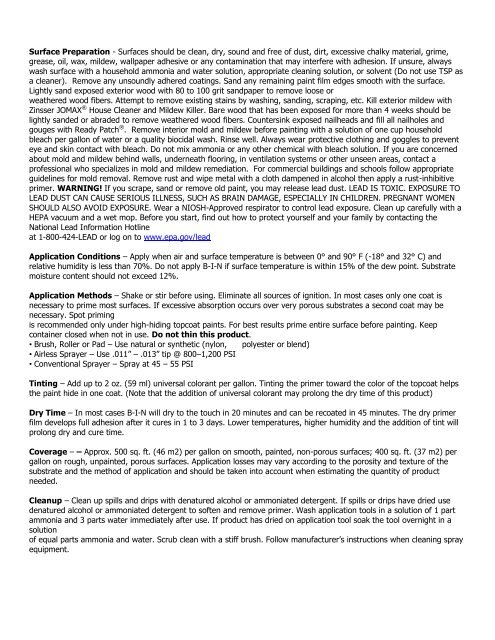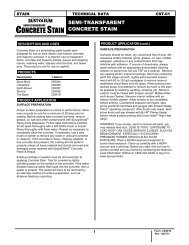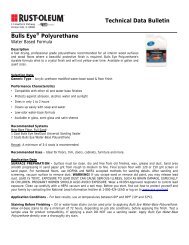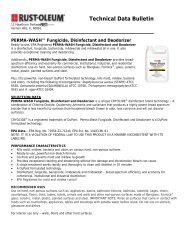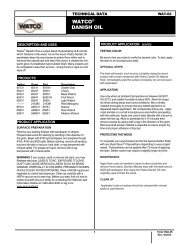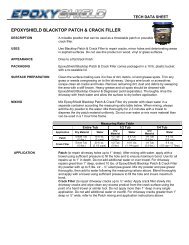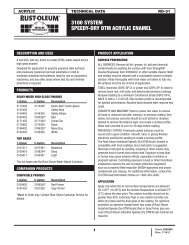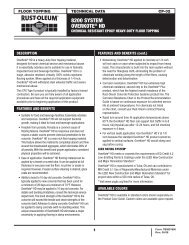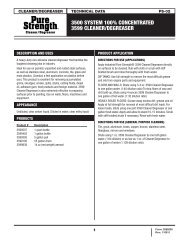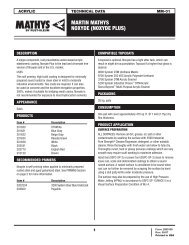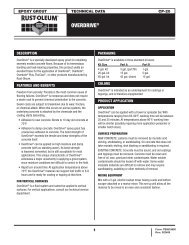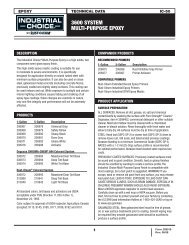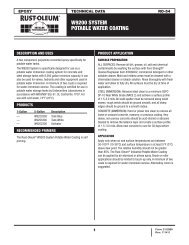Technical Data Bulletin ® - RustoleumIBG.Com
Technical Data Bulletin ® - RustoleumIBG.Com
Technical Data Bulletin ® - RustoleumIBG.Com
You also want an ePaper? Increase the reach of your titles
YUMPU automatically turns print PDFs into web optimized ePapers that Google loves.
Surface Preparation - Surfaces should be clean, dry, sound and free of dust, dirt, excessive chalky material, grime,<br />
grease, oil, wax, mildew, wallpaper adhesive or any contamination that may interfere with adhesion. If unsure, always<br />
wash surface with a household ammonia and water solution, appropriate cleaning solution, or solvent (Do not use TSP as<br />
a cleaner). Remove any unsoundly adhered coatings. Sand any remaining paint film edges smooth with the surface.<br />
Lightly sand exposed exterior wood with 80 to 100 grit sandpaper to remove loose or<br />
weathered wood fibers. Attempt to remove existing stains by washing, sanding, scraping, etc. Kill exterior mildew with<br />
Zinsser JOMAX <strong>®</strong> House Cleaner and Mildew Killer. Bare wood that has been exposed for more than 4 weeks should be<br />
lightly sanded or abraded to remove weathered wood fibers. Countersink exposed nailheads and fill all nailholes and<br />
gouges with Ready Patch <strong>®</strong> . Remove interior mold and mildew before painting with a solution of one cup household<br />
bleach per gallon of water or a quality biocidal wash. Rinse well. Always wear protective clothing and goggles to prevent<br />
eye and skin contact with bleach. Do not mix ammonia or any other chemical with bleach solution. If you are concerned<br />
about mold and mildew behind walls, underneath flooring, in ventilation systems or other unseen areas, contact a<br />
professional who specializes in mold and mildew remediation. For commercial buildings and schools follow appropriate<br />
guidelines for mold removal. Remove rust and wipe metal with a cloth dampened in alcohol then apply a rust-inhibitive<br />
primer. WARNING! If you scrape, sand or remove old paint, you may release lead dust. LEAD IS TOXIC. EXPOSURE TO<br />
LEAD DUST CAN CAUSE SERIOUS ILLNESS, SUCH AS BRAIN DAMAGE, ESPECIALLY IN CHILDREN. PREGNANT WOMEN<br />
SHOULD ALSO AVOID EXPOSURE. Wear a NIOSH-Approved respirator to control lead exposure. Clean up carefully with a<br />
HEPA vacuum and a wet mop. Before you start, find out how to protect yourself and your family by contacting the<br />
National Lead Information Hotline<br />
at 1-800-424-LEAD or log on to www.epa.gov/lead<br />
Application Conditions – Apply when air and surface temperature is between 0° and 90° F (-18° and 32° C) and<br />
relative humidity is less than 70%. Do not apply B-I-N if surface temperature is within 15% of the dew point. Substrate<br />
moisture content should not exceed 12%.<br />
Application Methods – Shake or stir before using. Eliminate all sources of ignition. In most cases only one coat is<br />
necessary to prime most surfaces. If excessive absorption occurs over very porous substrates a second coat may be<br />
necessary. Spot priming<br />
is recommended only under high-hiding topcoat paints. For best results prime entire surface before painting. Keep<br />
container closed when not in use. Do not thin this product.<br />
• Brush, Roller or Pad – Use natural or synthetic (nylon, polyester or blend)<br />
• Airless Sprayer – Use .011” – .013” tip @ 800–1,200 PSI<br />
• Conventional Sprayer – Spray at 45 – 55 PSI<br />
Tinting – Add up to 2 oz. (59 ml) universal colorant per gallon. Tinting the primer toward the color of the topcoat helps<br />
the paint hide in one coat. (Note that the addition of universal colorant may prolong the dry time of this product)<br />
Dry Time – In most cases B-I-N will dry to the touch in 20 minutes and can be recoated in 45 minutes. The dry primer<br />
film develops full adhesion after it cures in 1 to 3 days. Lower temperatures, higher humidity and the addition of tint will<br />
prolong dry and cure time.<br />
Coverage – – Approx. 500 sq. ft. (46 m2) per gallon on smooth, painted, non-porous surfaces; 400 sq. ft. (37 m2) per<br />
gallon on rough, unpainted, porous surfaces. Application losses may vary according to the porosity and texture of the<br />
substrate and the method of application and should be taken into account when estimating the quantity of product<br />
needed.<br />
Cleanup – Clean up spills and drips with denatured alcohol or ammoniated detergent. If spills or drips have dried use<br />
denatured alcohol or ammoniated detergent to soften and remove primer. Wash application tools in a solution of 1 part<br />
ammonia and 3 parts water immediately after use. If product has dried on application tool soak the tool overnight in a<br />
solution<br />
of equal parts ammonia and water. Scrub clean with a stiff brush. Follow manufacturer’s instructions when cleaning spray<br />
equipment.


